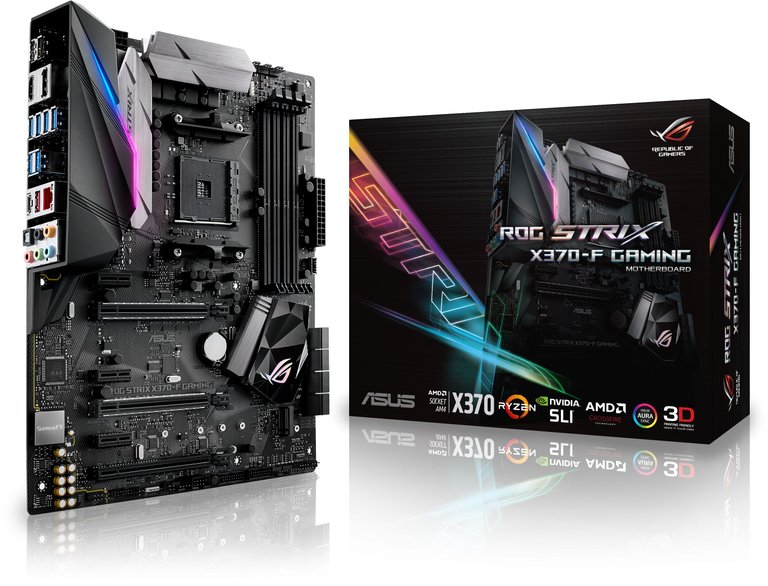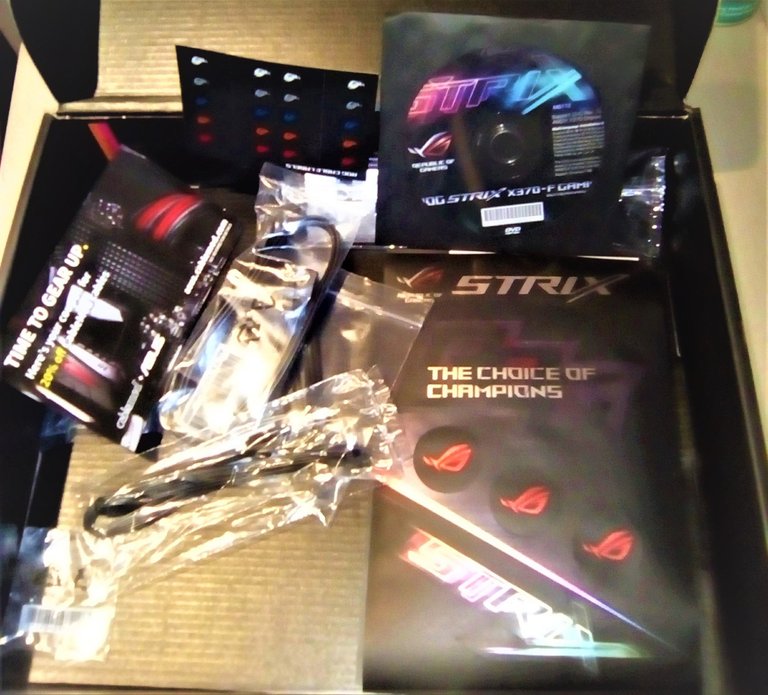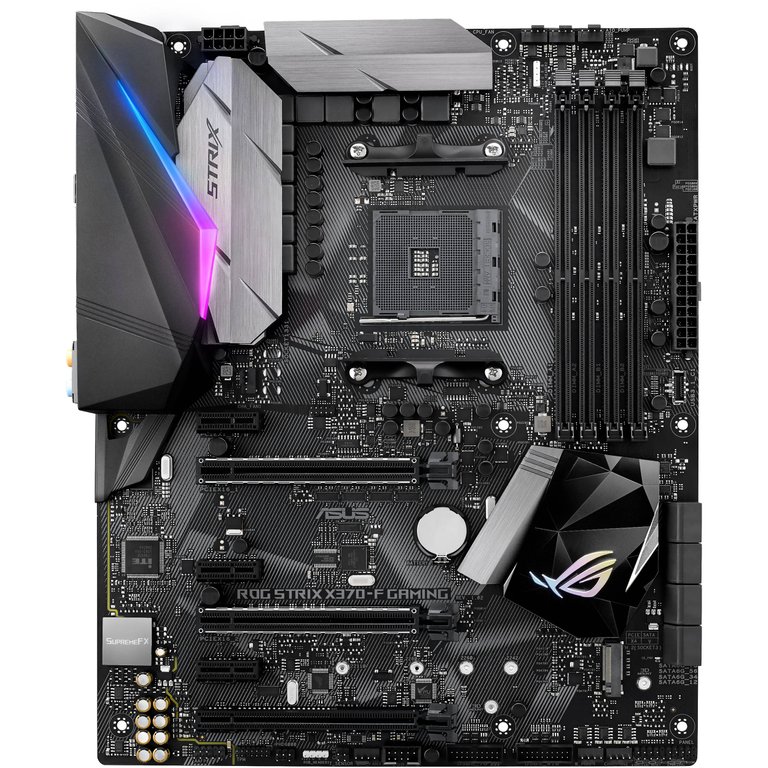It is going to be awesome getting a new gaming rig, and each time a new part arrives, its like Christmas all over again.

You can read Part One HERE.
After my last post, I opened my bitcoin wallet to see how much I had, and I thought I better buy something, before the value of bitcoin falls too much. Looking through what I originally planned for this build and the Prices, I ended up buying the ASUS X370-F ROG STRIX AM4 Motherboard, which arrived in the post this morning. Excited, I ripped open the packaging, popped a few of the bubbles in the bubble wrap, and shining like a bar of gold, there it was. So lets have a closer look at the features I got...

What's in the Box?

We have the Sexy ASUS Motherboard, (naturally) but we also get a few more bits that most other boards don't come with. There is 4 30cm SATA cables, 2 of which have a 90* head on one end. There is the User Manual, An instillation guide, a Driver disc, (I'm surprised they still come with these discs) there is a screw for the M.2 socket, a replacement stand off and screw, a bag of zip ties, a very good I/O shield with a non conductive sponge backing, a sheet of stickers, another sheet of smaller stickers which are in fact used for SATA identification, so you know what drive is connected to the motherboard, There is an ASUS SLI bridge that is a solid PCB and looks very good, ideal for running 2 Nvidia cards, and finally there is a 20% discount coupon for Cablemod.com. Which is very handy if you want some custom cables for your build, which I do, but for those that ordered everything in one go, it kinda sucks, but it is awesome non the less.

Cooling Mount.
So upon having a much closer look at the board, I was most impressed with it compatibility for coolers. When I was looking for a water block for a possible custom loop or an AiO, I found that there are not many options for the new AM4 socket. But there are plenty of options for the older AM3/AM3+ sockets.
Looking at this bracket, underneath you can just about see 2 more holes, just to the side. I wondered what they were for, but after a quick look into the user manual, I found it is capable of holding both AM3 and AM4 mounts. The only downside is you will need the AM3 backplate or an after market one if you do plan on using the AM3 mount. The upside is, it opens up a lot more options for cooling solutions.

GPU SLI and Crossfire.
The board itself is very impressive for gaming, as mentioned, it does come with an SLI bridge so you can run dual Nvidia cards, in the top 2 PCIe 16x slots. But there is a 3rd PCIe 16x slot at the bottom, this is for a third AMD Radeon graphics card so you can run 3 in crossfire.

Front I/O
Starting at the bottom right of the board we have the usual power, reset, PWR LED, HDD LED and speaker pins. Next there is two 4 pin fan headers followed by 2 USB 3.0 sockets, then there is a USB 2 socket with another 4 pin fan header. I have never seen this before, but there is a sensor header for system temperature, which I think is very cool. Carrying on we have our first RGB header which does not include white, so RGBW light strips or fans will not work on this unfortunately. Finally on the bottom there is the digital and analogue audio headers for the front audio jacks.
Moving onto the right side, next to the DIMM sockets and just under the 24 pin socket, there is a USB 3.1 type C header, ideal for more modern and high end cases that include a USB Type C.
At the top of the board there is three more 4pin fan headers that can be used for both fans or AiO Water Pumps. And lastly there is the second 4 pin RGB header.

Rear I/O
On the rear of the board, there is a wide selection of sockets. Starting on the left we have 2 USB2 sockets, next there is a Display Port and an HDMI port, this is for the next gen of AMD, APU chips that include Vega graphics, these will be released in April of this year. So if you want to build a PC with powerful on board graphics, this board will do the trick with next gen APU's. Moving along we have 6 USB3.0 ports, then there is a 10 gigabit Ethernet socket, below there is a USB3.1 type A and type C socket for ultra fast USB data transfer. Finally we have the usual audio sockets with a SPDIF optical socket too for good measure.

Internal Expansion.
As mentioned before, there are 3 PCIe 16x slots, the top 2 are for Nvidia SLI while all three are for AMD crossfire, but there is also 3 PCIe 4x sockets, interestingly, if the bottom PCIe 4x slot is occupied, you can not use the bottom 16x slot, and if the bottom 16x slot is occupied, you can not use the bottom 4x slot. Why it is like this I don't know, perhaps they ran out of PCI lanes to the AM4 CPU? But any way, continuing on, to the right of the PCIe slots we can find an M.2 header, if you have a Ryzen CPU on the board, the M.2 header can utilize both NVME and SATA drives, but if you are running an A series Athlon CPU it will only work with SATA drives. Finally to top the internal expansion off, there is 8, yes, 8 SATA 6gb ports, which is good for me as I have had to start using hot swap drives in my current PC as it only has 6 SATA ports.

Heat Sinks and Extras.
Looking around the top and left side of the CPU socket, there is a large aluminium heat sink on the VRM modules, this is very good for those of us who want to over clock, as those cheaper boards that don't have heat sinks or poor ones on the VRM, tend to die if overclocked, the VRM just burn out, so this is very good to see on a mid/high end motherboard.
There is also a large heat sink on the north bridge which also sports the ROG eye graphic which looks very cool, but it does not light up like the B350 ROG STRIX board, instead, the Rear I/O Armour has an RGB light on that, that can be controlled via the ASUS Aura software.


Overall, the board has a lot of features that allow enthusiasts, such as myself, to customise there build that much more while keeping things simple. The RGB expansions for example, if you use compatible RGB strips or fans, you can control them with the Aura software. I think even my Corsair Void wireless headset may work with Aura. That is something I will have to test once the build is finished.
A quick Reminder of what hardware will be included in the build...
| CPU | AMD Ryzen 1800X AM4. |
| Motherboard | ASUS X370-F ROG STRIX AM4 |
| RAM | 32Gb G.Skill Trident Z RGB 3200Mhz. |
| GPU | AMD Radeon RX 580 x 2 in Crossfire. |
| Cooling | Custom Water Loop or, Corsair H150i Pro AiO 360mm Rad |
| Case | Custom Desk Case or, ThermalTake Core x5 Snow Glass Cube. |
As for the rest of the parts, I already have a PSU to which I will review in a future post, and I already have more storage than you can shake a stick at. It is just a matter of ordering the rest of the parts, as and when money is available to do so.
Thanks for reading.

Don't Forget to Upvote, ReSteem and Follow for more content like this!

Stu @TechMojo
Join the chat TechMojo Discord Channel Follow us TechMojo OnG Social Page Like us TechMojo Facebook Page Follow us TechMojo Twitter
@TechMojo Recommended Blogs you should follow.
Like this Content? Why Not Donate Then.
Bitcoin Wallet Address. 1L8TZDQasoBU2RNcjkSeZX3iUsSaHT37aj Ethereum Wallet Address. 0xe3c6372121554f73c38acae3312fc7b1ddaf670f






wow man!!! your a so lucky because now you have a gaming pc with high configuration.
Oh!
congrats mate!
Really a nice setup.Worth it! now you should be able play GTA5,Far Cry5,Ac Origins in 4k resulation.And yeah i apreiciate this setup.This is beast to play games. If u know what i really mean
i know exactly what you mean. cheers buddy.
good for gamers..... expecting far cry, god of war and dishonored this system is the best option
question is.... can it play Crysis?
oww man.. you are so lucky.. i wish i had it😰keep gaming
happy gaming..
keep sharing.. i am with you👌
cheers buddy.
cheers👌✌
ROG are very, very nice hardware. Now, are you going to use that for gaming, or are you going to mine with it?
it will purly be for gaming/streaming... the pc it is replacing will be used as part of my Journey into mining post series.. as i am still very much a noob when it comes to mining.
Learn from my fail: Don't mine bitcoin. It's not worth it. Look to other cryptocurrencies. The Nicehash miner is good for benchmarking your machine, but look to other pools.
i use node miner like claymore dual miner which i use for ethereum and pascal. dont trust one click miners.
Fair. Nicehash was good for being so simple to use. Now that I know more about what I'm doing, I'm more willing to take things into my own hands.
This board is a beast.
I wanted to ask my dad every day gaming pc but every time forget me. really you got a lot of luck
In the end of wllit id for what?
huh?
what?